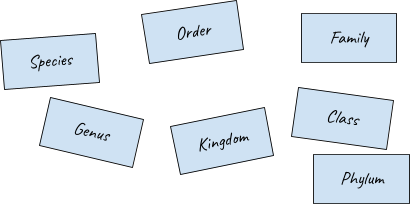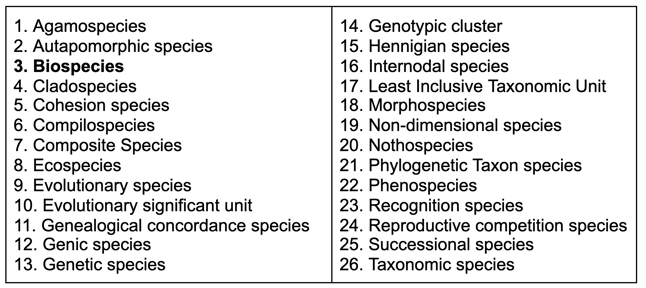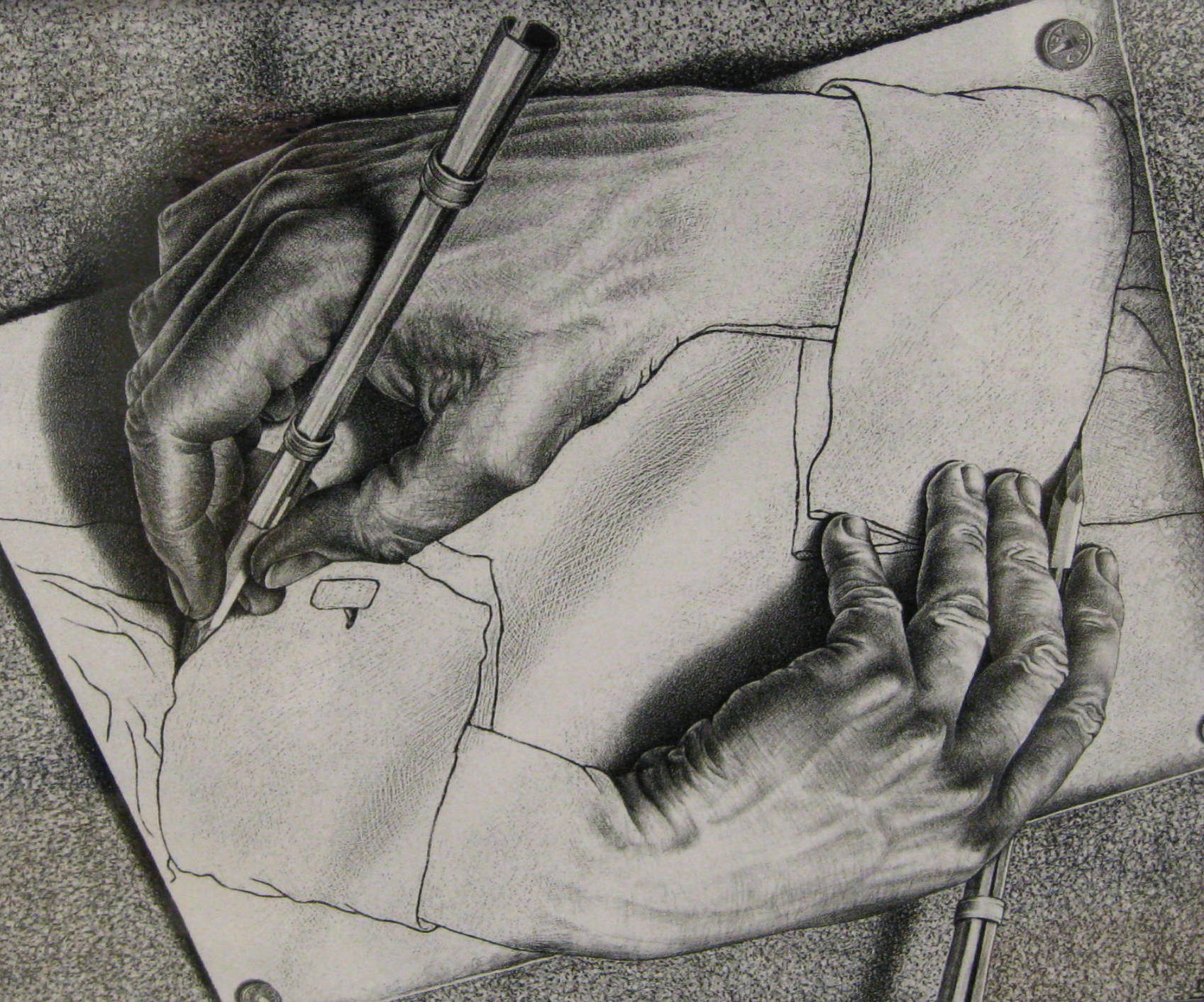Is rote learning bad? No, but it’s not enough.
Let’s take an example where a learner is asked to understand the species concept, a categorization system that explains that all life is organized according to: Kingdom, Phylum, Class, Order, Family, Genus, Species. There’s a few ways one might go through this process of being able to remember the species concept. First, a student might use flash cards:

Figure 1. Flash cards to remember the elements of the species concept.
We might ask them to review the cards and/or put the cards in order, repetitively. The exposure and repetition would therefore aid in storage to long-term memory and the ability to recall [a].
Where ordering is concerned, we may even use a mnemonic device such as, “Kings Play Chess On Fridays Generally Speaking” because the order of these words have some meaning. That is, one can imagine Kings, playing chess on Fridays being generally true. Even if the meaning of the sentence is absurd, it is more meaningful than the list of words itself: Kingdom, Phylum, Class, Order, Family, Genus, Species. In doing so, we have created a cognitive structure for the words that gives it more meaning:

Figure 2. An R-channel jig used to memorize using a mnemonic device.
The basic model of memory that is widely accepted (not without criticism) is called the Modal Model of Mind [1]. It looks like this:
.png?width=700&name=copy%20of%20modal%20memory%20model%20(1).png)
Figure 3. The Modal Model of Mind (map).
According to this model, the Rote Learning process detailed above (with exposure and rehearsal) will be successful in causing the ‘KPCOFGS species concept’ structure to be stored in long-term memory and therefore capable of recall.
The question that remains however, is two-fold: (1) what was actually ‘learned’? and, (2) to what end? The first question is relatively easy to answer because we can capture it on a variety of tests. For example, in order of difficulty:

Table 1. A few possible tests in order of difficulty.
Our tests reveal that the ‘learning’ from the lesson is comprised of two basic things, perhaps three. First, the recall of the items themselves: Class, Family, Genus, Kingdom, Order, Phylum, and Species. Second, recall of the order of the list: Kingdom, Family, Order, Class, Phylum, Genus, and Species. Third, but significantly less discrete, is the students ability to explain the species concept. This would perhaps, at the very most, include an understanding that all living organisms are organized into these 7 categories and at the least, would be something akin to recalling the items and their order. Suffice to say, there is little true understanding developed. But, they may well remember the mnemonic device and the items and order into adulthood.
The second question is a bit harder to answer: To what end? If the goal is to get students to remember the 7 items and their order (and perhaps a rudimentary if not essentially misinformed understanding of the species concept) well into adulthood then mission accomplished. But, one would hope we could aspire to something more, pragmatic. More useful. A better use of everyone’s time. When was the last time you interviewed for a job and were asked, "Can you name the 7 ordered items of the species concept?" Indeed, to what end? is the important question. Perhaps we are attempting to engage them in the wonders of biology in the hopes that some of them will ‘catch the bug’ and become biologists. Or, perhaps it's just practice for adulthood of how one might come to know things. Or myriad other reasons. But, whatever the goal of the learning might be, it reflects on what exactly is to be learned. As we said above, is it merely the 7 items and their order that is to be learned? If so, mission accomplished.
But let’s say that we want something more than that. Let’s say that we want students to be able to understand in a meaningful way (not a superficial way) the species concept and demonstrate how it might be applied (i.e., its value) by scientists. In that case, they will need something more than the 7 ordered items committed to memory.
This leads us to the idea of mental model matching (MMM): a technique that can be used to determine the difference between the students’ current state of understanding and the target or goal state. For example, Figure 4 provides a current state and target DSRP map for 6th, 9th 11th grade standards in ‘ELA’ or English Language Arts. Note that the target, once achieved, becomes the new current state.
Figure 4. 6th grade, 9th grade, and 11th grade mental models of what it means to ‘cite specific textual evidence.’ Note that colors additively identify the differences among the models.
Mental Model Matching (MMM) [2] can be used at any time throughout the pedagogical process. It is, in one sense, a slightly more refined version of ‘Vygotskian learning’ and the ‘zone of proximal development’ (ZPD) summarized as, “if the student hits every time the target is too near, if they miss every time the target is too far.” The idea being that we, as guides to learning, must not only have a target [mental model] but also the current state of the student and an understanding of the relative difference (or ‘distance’) between them. MMM can, and should, be used before during and after a lesson in a formal way for all students in the class, or in situ, informally with an individual student. Informally and in situ, when a student is struggling, a teacher may use contextual cues to quickly build a mental model of the current state and then compare and contrast this with the target and adjust as needed. Likewise, more formally, a teacher will have a presumptive and normative current state for their entire classroom and compare that with the desired target of learning. Either way, the idea is that mental models are built on structure and information so these different states must not only show the difference in information, but also the differences in structure.
The MMM idea then is incorporated with two other essential functions of learning that together form a pedagogical model called Map, Activate, Check or MAC [3-4]. MAC is described in Figure 5 where the M in M.A.C. is Mental Model Matching (MMM).
Figure 5. Map Activate Check Functions of Learning (pdf). [3]
The A in MAC is for the Activation function of learning and is based on a number of important findings in cognitive and neuroscience; namely, that of the embodied nature of cognition. That is, unlike computers that have near perfect recall and memory but little to no meaning because all they are doing is symbol manipulation, humans need to ‘ground’ their symbols in experience in order to make meaning of the symbols. Thus, the learning process described above where students memorized the 7 items and order exhibited a low degree of symbol grounding, thus the symbols (i.e., Kingdom, Phylum, Order, Class, Family, Genus, and Species) resulted in very little meaning to the student. They were able to recall them but very little else because the grounding was superficial both informationally (i.e., “Kings Play Chess On Fridays Generally Speaking”) and structurally (i.e., simple lists). The activation function of learning is described in Figure 6.
Figure 6. The Continuum of Types of Techniques that Can Be Used for Activation (pdf). [4]
Contrary to popular practice, the goal of Activation is to identify the least elaborate (e.g., complex or costly in time and resources) activation method (see Figure 6) that will get the job done. For example, we don’t need to use a 30-day immersion experience to teach the species concept. But we may need a 30-day immersion experience to teach empathy, self-reliance, craftsmanship, and teamwork.
Note that in our species concept lesson above, we might add a bit more to the lesson based on the M and A functions of MAC. Here are 7 things we could do to change this lesson and make it better.
#1
Help students to understand that Kingdom, Family, Order, Class, Phylum, Genus, and Species are not equal categories (as is often mistaken) but nested categories. An image such as that in Figure 7 illustrates this nested part-whole structure.
Figure 7. The Nested Part-Whole Structure of the Biological Species Concept.
#2
We might put the Species Concept in context by showing that it is just one (the most popular one) of 26 different organizing schema used by scientists to classify living organisms. Different organizing schema are used for different scientific purposes like tools are used for different jobs. Table 2 lists the 26.
Table 2. The many organizing schema scientists use for classifying life.
#3
As part of this analysis we might help students understand a fundamental cognitive structure or “jig” called the S to P jig which all 26 organizing structures including the Species Concept are. An S to P jig is a structure that consists of a system of concepts put together to use as an organizing lens on some other set of phenomena. Figure 8 illustrates the basic structure of the S to P Jig. Figure 9 shows how the biological species concept is an S to P Jig.
Figure 8. The basic structure of an S to P Jig. [5]
Figure 9. The Biological Species Concept is an S to P Jig that scientists use to get their job done.
#4
So far you’ve thrown a number of mental models at your students and used imagery and cognitive structure to help them Activate. Further activation might include some practice. One powerful way to connect to students is to increase relevancy and because they are human, having them classify humans is a good way to not only learn about themselves but also learn about the species concept. Figure 10 shows the species concept applied to humans. Here again, traditional rote techniques (drill and skill) can be used to memorize the items to the right. In other words, rote techniques for developing memorization in a fast way so it can be used for a more depthful analysis are not “bad” they are just not “enough.” So, for example, flash cards could be used to commit the terminology at left in Figure 10 to memory.
Figure 10. Making the Species Concept Relevant.
#5
Item #4 provides the first step to the classic pedagogical technique: “See one. Do one. Teach one.” Now have students use the S to P jig that is the biological species concept for what it was designed for, to classify organisms. Especially new ones! Invent an entirely new species in the spirit of the field of speculative evolution and have students attempt to classify it using the S to P Biological Species Concept. Figure 11 shows such a species...Figure 11. A rhinograde, using its nasorium to catch fish. Rhinogrades, created by Gerolf Steiner in 1957, are one of the earliest concrete examples of speculative zoology.
#6
Finally, you may want to ensure that you students gain both a healthy respect and irreverence for the biological species concept by sharing with them some of its known flaws and also giving them a task that illustrates just how difficult it is to come up with even a flawed model to organize all of life. For example, you might have them research “criticism of the biological species concept” and report on it. Then, based on these criticism, ask them to use the S to P jig to devise a ‘better species concept.’ In this way, you will be training them to actually think and behave like scientists!
#7
The final step in MAC is “Check.” It is absolutely critical that you help your students to include this vital element of learning. Contrary to popular opinion, it is not true that we learn from experience. If we did, then we would not see so many people repeat the same mistakes. What is true is that we learn from reflecting on our experience. The Check function of learning is the natural feedback loop that is necessary for learning to occur and to be more aware of its occurrence. Often this “check” function is thought of as a way for the teacher to check the understanding of the students which invariably comes down to testing. But the check function of learning is far more important to place in the hands of the learner because this will build one of the primary skills of lifelong-learning: the ability to say, have I learned what I needed to learn? Thus, identify ways that students can identify what they learned. Involve them in devising the test, or use tests as a way to show them what they should have learned (what was important, salient, germane). While not always possible, the closer the “Check” (test) comes to residing in the student, of the student, and for the student, the better.
So, is rote learning 'bad'? No. But depending on what you identify as rote learning, it is not enough. For example, if rote learning is "repetition and rehearsal" then the suggestions I've made above are chock-full of repetition and rehearsal. You'll notice, for example, that we covered the species concept in no less than seven different ways. That's repetition and rehearsal, but it is also structuring information from different perspectives, establishing relevancy, grounding through activation, and much more. The point is, rote learning is a powerful tool in the arsenal, but it isn't the arsenal itself. The bottom line is, you need to help learners structure (DSRP) the information in meaningful mental models and activate those mental models in as many ways as practicable. In the end, pedagogy needs to be constructionist versus instructionist. It needs to focus on structure and what the learner is building (constructionist) over content and what the teacher is covering (instructionist) [8].
Footnotes
[a] Note that this cognitive structure is several jigs. First, it is two lists. Second, it is an R-channel. Third, it is a mix and match jig (a jig combining two or more jigs). But the use of this R-channel structure for the mnemonic device is limited because the mnemonic is meaningless to an understanding of the content itself. So while the structure is helpful in encoding and rehearsal is present (thereby leading to long-term memory) the meaning of the structure is extremely low. Thus deep understanding is low.
Citations:
[1] Mulyono Oktavia, Y., Cabrera, E., Sukhbaatar, U., Cabrera, L., Cabrera, D. (2021) A Systemic Lens on the Modal Model of the Mind. In, Routledge Handbook of Systems Thinking, (Eds) Cabrera, D., Cabrera, L. and Midgley, G. Routledge. London, UK.
[2] Cabrera, D., Cabrera, L., Powers, E., Solin, J., & Kushner, J. (2018). Applying systems thinking models of organizational design and change in community operational research. European Journal of Operational Research. 268 (2018) 932–945 doi:10.1016/j.ejor.2017.11.006
[3] Solin, J. (2021) A Systems Thinking-based Approach to Curriculum and Program Design: Map-Activate-Check. In, Routledge Handbook of Systems Thinking, (Eds) Cabrera, D., Cabrera, L. and Midgley, G. Routledge. London, UK.
[4] Cabrera, D. and Cabrera, L. (2019). Complexity and Systems Thinking Applications in Education. In: Spector M., Lockee B., Childress M. (eds) Learning, Design, and Technology: An International Compendium of Theory, Research, Practice, and Policy. Springer. NY.
[5] ___. (2016) CRL. Three Steps For Designing Better Learning Experiences: Map, Activate, Check and Activation Continuum., Cabrera Research Lab.
[6] ___. (2016) CRL. The Purpose of an Activity is to Activate a Concept., Cabrera Research Lab.
[7] Staff. S to P Jig: The Jig ALL Frameworks Were Built Upon. Systems Thinking Daily. 2020;20: 10.
[8] Cabrera, D., & Cabrera, L. (2011) Thinking at Every Desk: Four Simple Skills to Transform Your Classroom. Norton Books in Education.
.png?width=150&height=150&name=CRL%20GOAT%20Logo%20(4).png)

